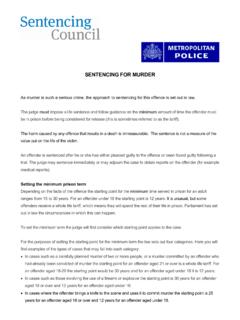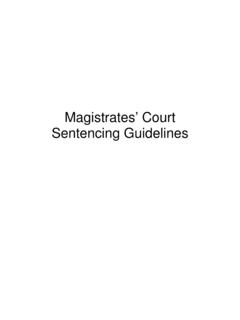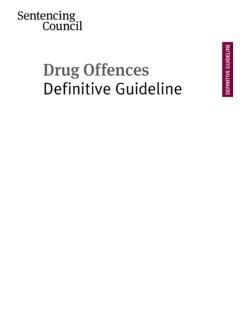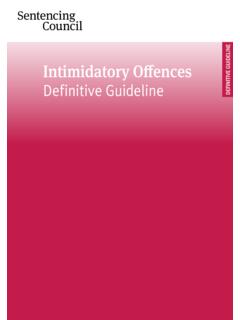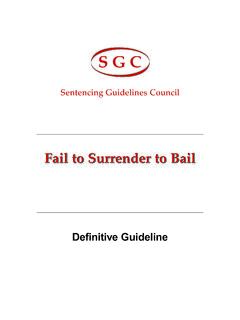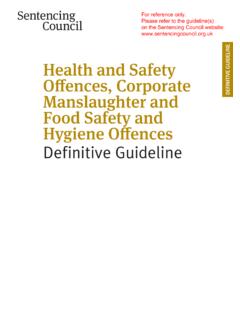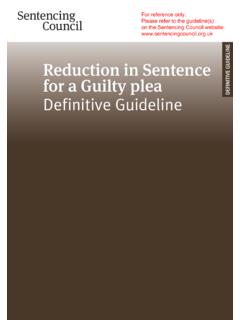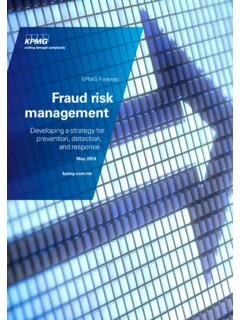Transcription of Fraud, bribery and money laundering offences: Definitive ...
1 Definitive GUIDELINE. Fraud, bribery and money laundering Offences Definitive Guideline Fraud, bribery and money laundering Offences Definitive Guideline 1. Contents Applicability of guideline 4. Fraud 5. Fraud by false representation, fraud by failing to disclose information, fraud by abuse of position Fraud Act 2006 (section 1). Conspiracy to defraud Common law False accounting Theft Act 1968 (section 17). Possessing, making or supplying articles for use in fraud 13. Possession of articles for use in frauds Fraud Act 2006 (section 6). Making or supplying articles for use in frauds Fraud Act 2006 (section 7). Revenue fraud 19. Fraud Conspiracy to defraud (common law). Fraud Act 2006 (section 1). False accounting Theft Act 1968 (section 17). Fraudulent evasion of VAT; False statement for VAT purposes;. Conduct amounting to an offence Value Added Tax Act 1994 (section 72).
2 Effective from 1 October 2014. 2 Fraud, bribery and money laundering Offences Definitive Guideline Fraudulent evasion of income tax Taxes management Act 1970 (section 106A). Fraudulent evasion of excise duty; Improper importation of goods Customs and Excise management Act 1979. (sections 50, 170 and 170B). Fraud Cheat the public revenue (common law). Benefit fraud 27. Dishonest representations for obtaining benefit etc Social Security Administration Act 1992 (section 111A). Tax Credit fraud Tax Credits Act 2002 (section 35). False accounting Theft Act 1968 (section 17). False representations for obtaining benefit etc Social Security Administration Act 1992 (section 112). Fraud by false representation, fraud by failing to disclose information, fraud by abuse of position Fraud Act 2006 (section 1). Conspiracy to defraud Common law money laundering 35.
3 Concealing/disguising/converting/transfe rring/removing criminal property from England & Wales Proceeds of Crime Act 2002 (section 327). Entering into arrangements concerning criminal property Proceeds of Crime Act 2002 (section 328). Acquisition, use and possession of criminal property Proceeds of Crime Act 2002 (section 329). Effective from 1 October 2014. Fraud, bribery and money laundering Offences Definitive Guideline 3. bribery 41. Bribing another person bribery Act 2010 (section 1). Being bribed bribery Act 2010 (section 2). bribery of foreign public officials bribery Act 2010 (section 6). Corporate Offenders 47. Fraud Conspiracy to defraud (common law). Cheat the public revenue (common law). Fraud Act 2006 (sections 1, 6 and 7). Theft Act 1968 (section 17). Value Added Tax Act 1994 (section 72). Customs and Excise management Act 1979 (section 170).
4 bribery bribery Act 2010 (sections 1, 2, 6 and 7). money laundering Proceeds of Crime Act 2002 (sections 327, 328, 329). Annex: Fine bands and community orders 54. Crown copyright 2014. You may re-use this information (not including logos) free of charge in any format or medium, under the terms of the Open Government Licence. To view this licence, visit or email: Effective from 1 October 2014. 4 Fraud, bribery and money laundering Offences Definitive Guideline Applicability of guideline I. n accordance with section 120 of the Coroners Structure, ranges and starting points and Justice Act 2009, the Sentencing Council For the purposes of section 125(3) (4) Coroners issues this Definitive guideline. It applies to and Justice Act 2009, the guideline specifies all individual offenders aged 18 and older and offence ranges the range of sentences to organisations who are sentenced on or after appropriate for each type of offence.
5 Within each 1 October 2014, regardless of the date of the offence, the Council has specified a number offence. of categories which reflect varying degrees of seriousness. The offence range is split into category Section 125(1) of the Coroners and Justice Act 2009 ranges sentences appropriate for each level provides that when sentencing offences committed of seriousness. The Council has also identified a after 6 April 2010: starting point within each category. Every court Starting points define the position within a category range from which to start calculating the provisional (a) must, in sentencing an offender, follow any sentence. The court should consider further sentencing guideline which is relevant to the features of the offence or the offender that warrant offender's case, and adjustment of the sentence within the range, including the aggravating and mitigating factors set (b) must, in exercising any other function relating out at step Starting points and ranges apply to to the sentencing of offenders, follow any all offenders, whether they have pleaded guilty or sentencing guidelines which are relevant to the been convicted after trial.
6 Credit for a guilty plea is exercise of the function, taken into consideration only after the appropriate sentence has been unless the court is satisfied that it would be contrary to the interests of justice to do so. Information on community orders and fine bands is set out in the annex at page 54. This guideline applies only to individual offenders aged 18 and older or organisations. General principles to be considered in the sentencing of youths are in the Sentencing Guidelines Council's Definitive guideline, Overarching Principles . Sentencing Youths. 1 Aggravating and mitigating factors are at step four in the guideline for organisations. In the guideline for organisations, having identified a provisional sentence within the range at step four, the court is required to consider a further set of factors that may require a final adjustment to the sentence at step five 2 In the guideline for organisations, guilty pleas are considered at step seven; in the guidelines for individuals, guilty pleas are considered at step four Effective from 1 October 2014.
7 Fraud, bribery and money laundering Offences Definitive Guideline 5. Fraud FRAUD. Fraud by false representation, fraud by failing to disclose information, fraud by abuse of position Fraud Act 2006 (section 1). Triable either way Conspiracy to defraud Common law Triable on indictment only Maximum: 10 years' custody Offence range: Discharge 8 years' custody False accounting Theft Act 1968 (section 17). Triable either way Maximum: 7 years' custody Offence range: Discharge 6 years and 6 months' custody Effective from 1 October 2014. 6 Fraud, bribery and money laundering Offences Definitive Guideline STEP ONE. Determining the offence category The court should determine the offence category with reference to the tables below. In order to determine the category the court should assess culpability and harm. FRAUD. The level of culpability is determined by weighing up all the factors of the case to determine the offender's role and the extent to which the offending was planned and the sophistication with which it was carried out.
8 Culpability demonstrated by one or more of the following: A High culpability A leading role where offending is part of a group activity Involvement of others through pressure, influence Abuse of position of power or trust or responsibility Sophisticated nature of offence/significant planning Fraudulent activity conducted over sustained period of time Large number of victims Deliberately targeting victim on basis of vulnerability B Medium culpability Other cases where characteristics for categories A or C are not present A significant role where offending is part of a group activity C Lesser culpability Involved through coercion, intimidation or exploitation Not motivated by personal gain Peripheral role in organised fraud Opportunistic one-off' offence; very little or no planning Limited awareness or understanding of the extent of fraudulent activity Where there are characteristics present which fall under different levels of culpability, the court should balance these characteristics to reach a fair assessment of the offender's culpability.
9 Effective from 1 October 2014. Fraud, bribery and money laundering Offences Definitive Guideline 7. Harm is initially assessed by the actual, intended or risked loss as may arise from the offence. The values in the table below are to be used for actual or intended loss only. Intended loss relates to offences where circumstances prevent the actual loss that is intended to be caused by the fraudulent activity. FRAUD. Risk of loss (for instance in mortgage frauds) involves consideration of both the likelihood of harm occurring and the extent of it if it does. Risk of loss is less serious than actual or intended loss. Where the offence has caused risk of loss but no (or much less) actual loss the normal approach is to move down to the corresponding point in the next category. This may not be appropriate if either the likelihood or extent of risked loss is particularly high.
10 Harm A Loss caused or intended Category 1 500,000 or more Starting point based on 1 million Category 2 100,000 500,000 or Risk or category 1 harm Starting point based on 300,000. Category 3 20,000 100,000 or Risk of category 2 harm Starting point based on 50,000. Category 4 5,000 20,000 or Risk of category 3 harm Starting point based on 12,500. Category 5 Less than 5,000 or Risk of category 4 harm Starting point based on 2,500. Risk of category 5 harm, move down the range within the category Harm B Victim impact demonstrated by one or more of the following: The court should then take into account the level of harm caused to the victim(s) or others to determine whether it warrants the sentence being moved up to the corresponding point in the next category or further up the range of the initial category. High impact move up a category; if in category 1 move up the range Serious detrimental effect on the victim whether financial or otherwise, for example substantial damage to credit rating Victim particularly vulnerable (due to factors including but not limited to their age, financial circumstances, mental capacity).
